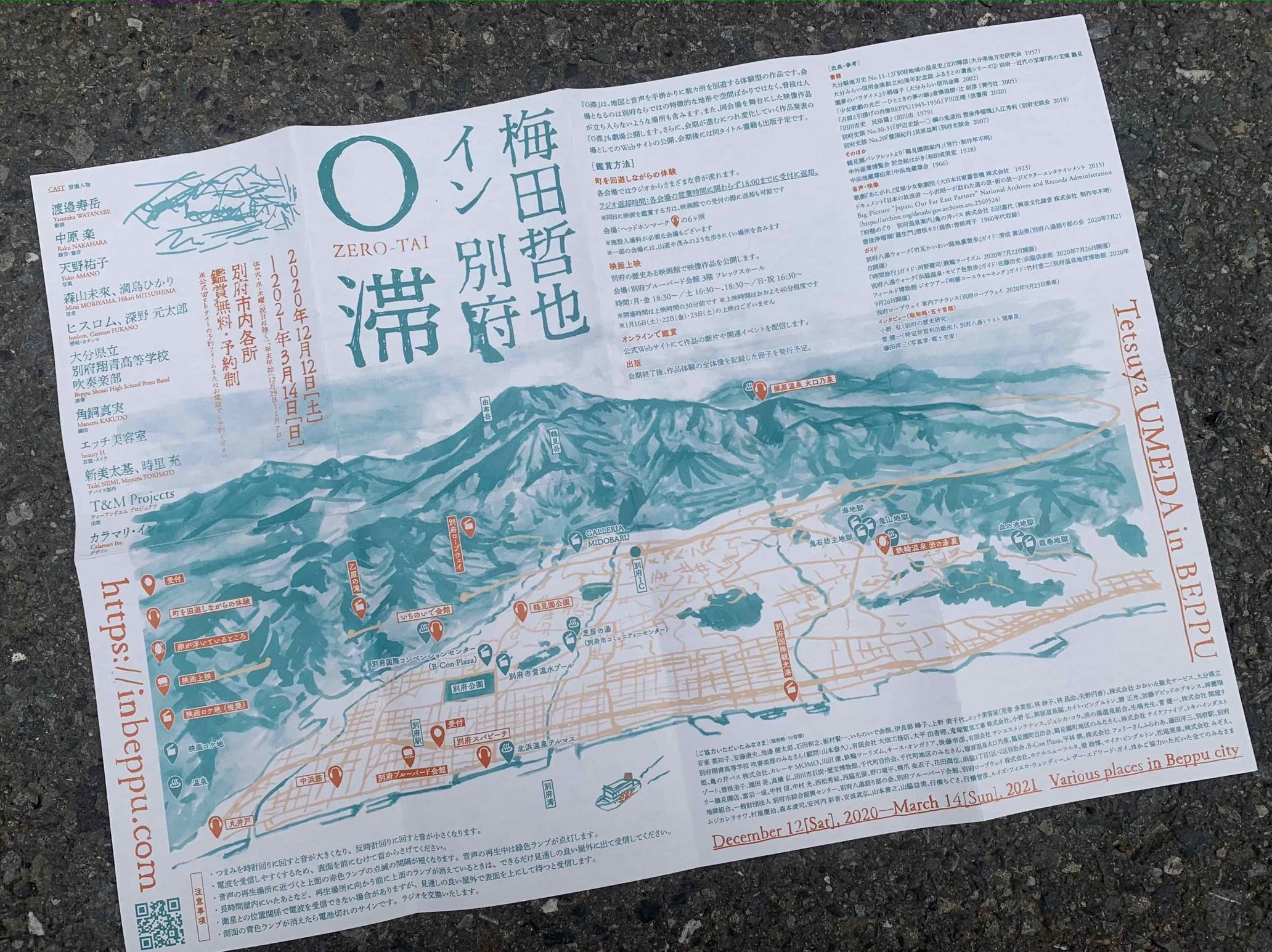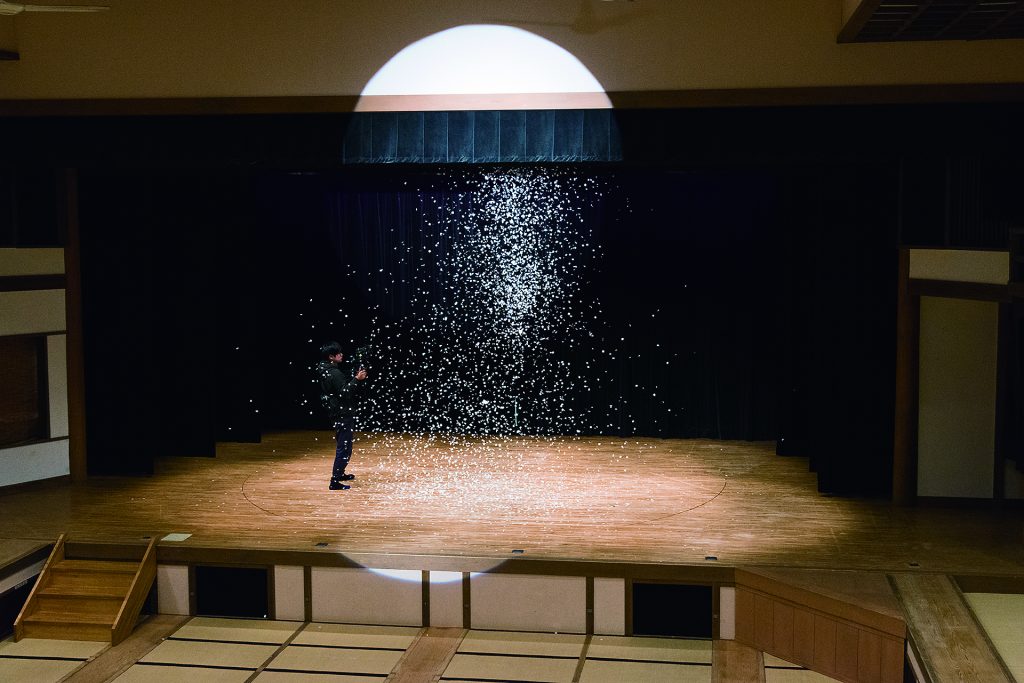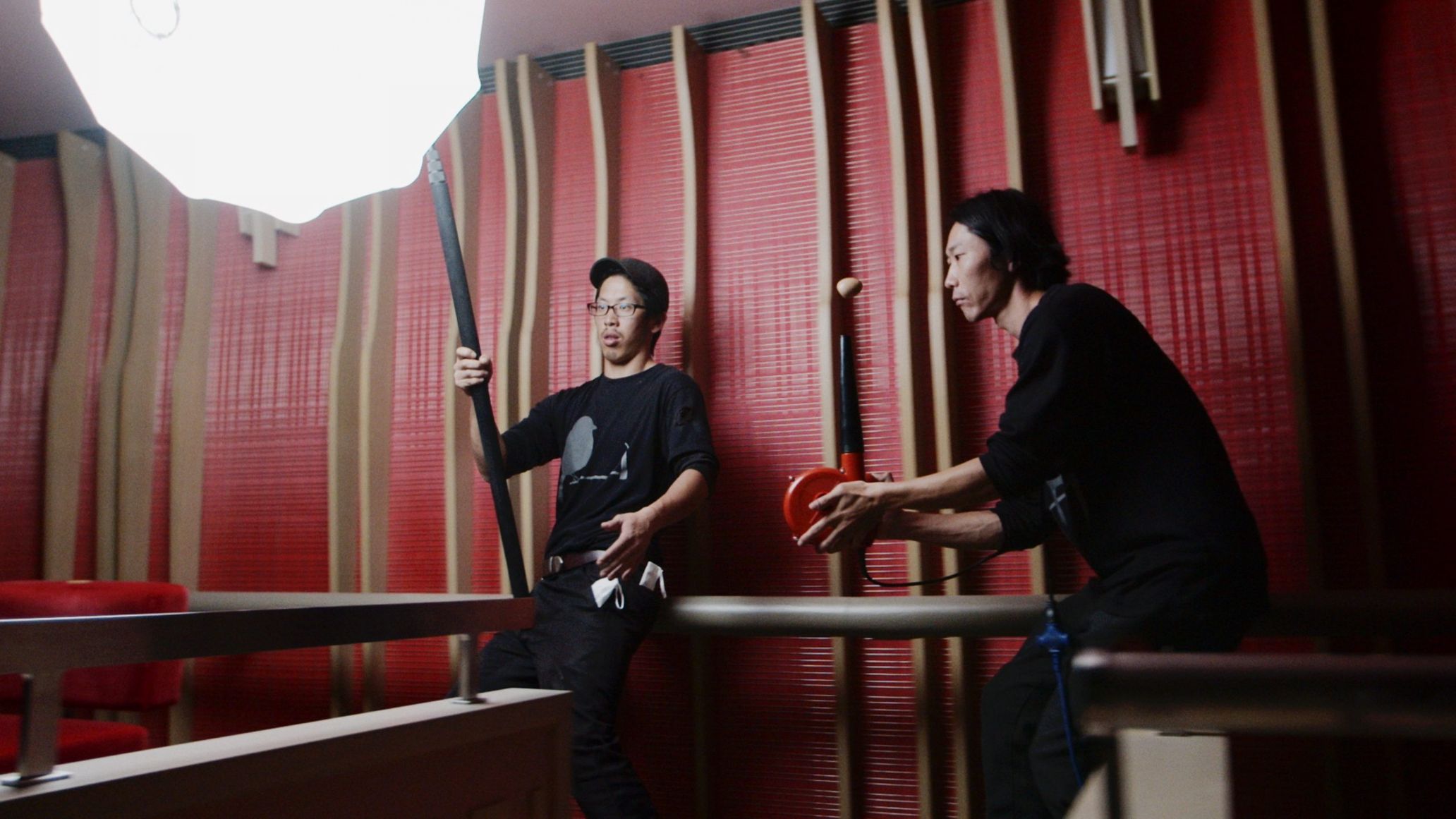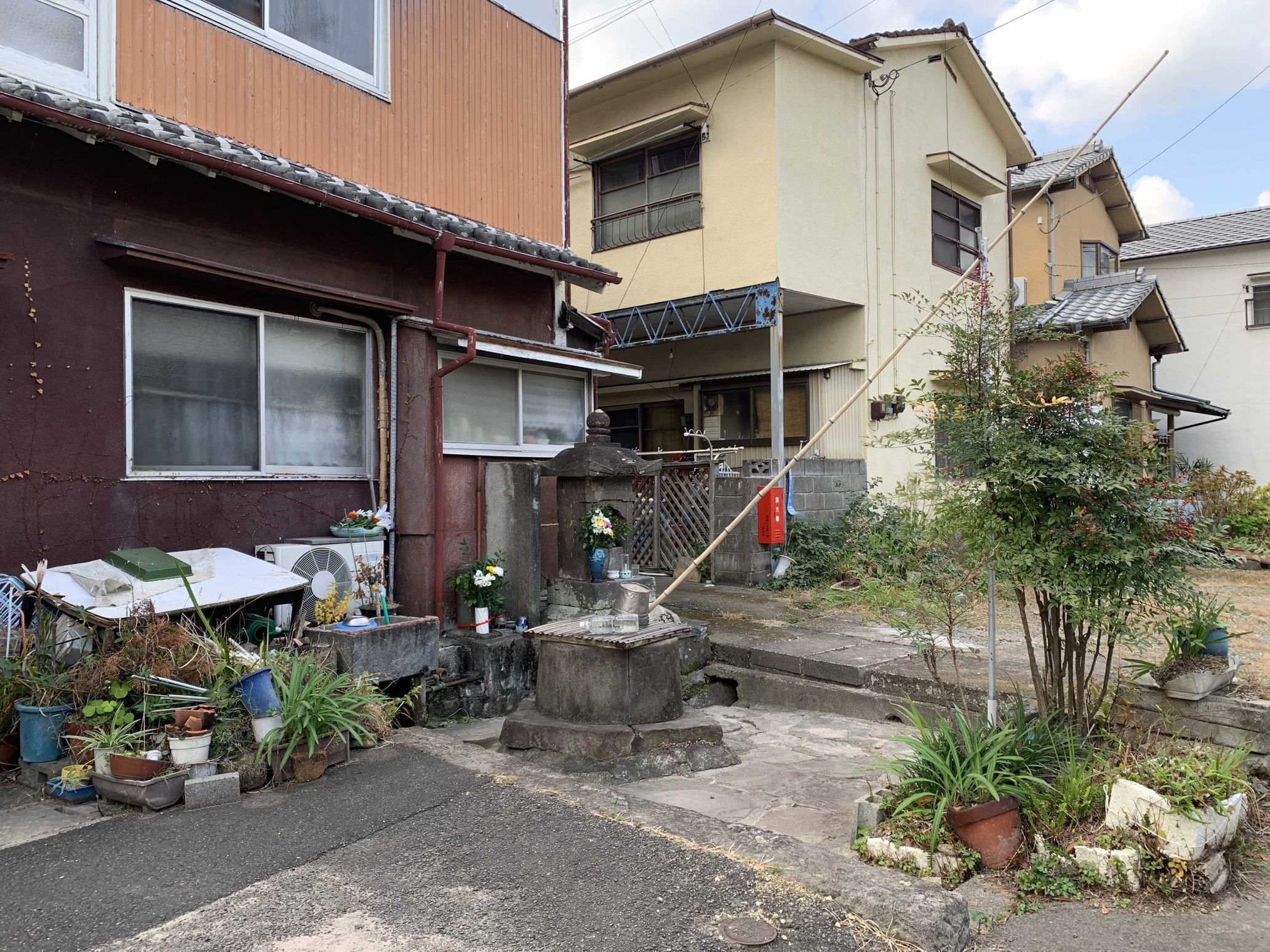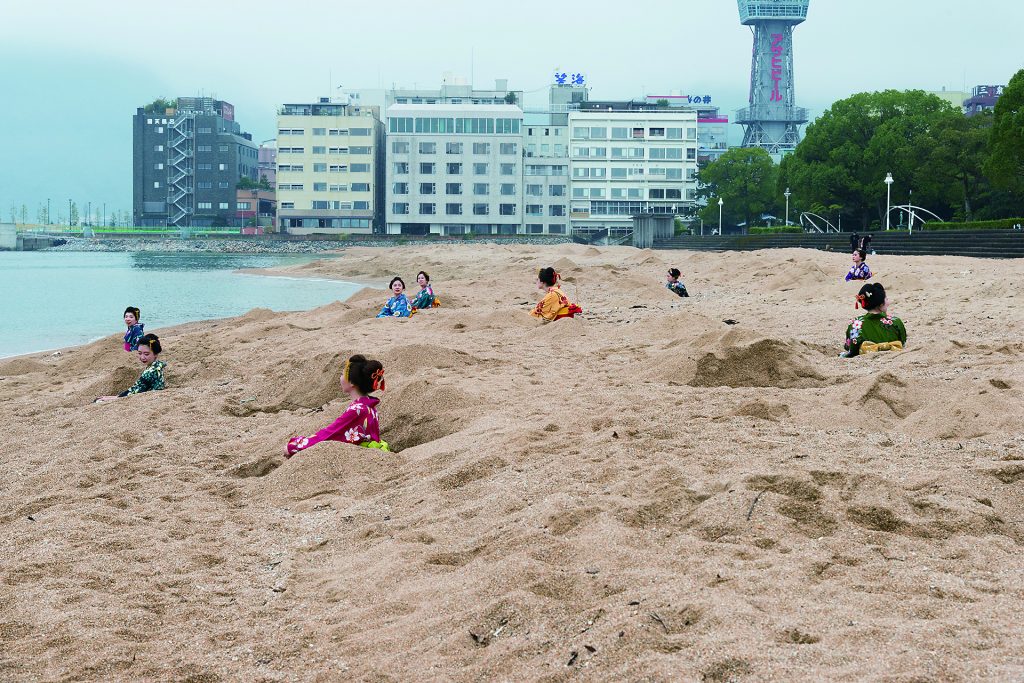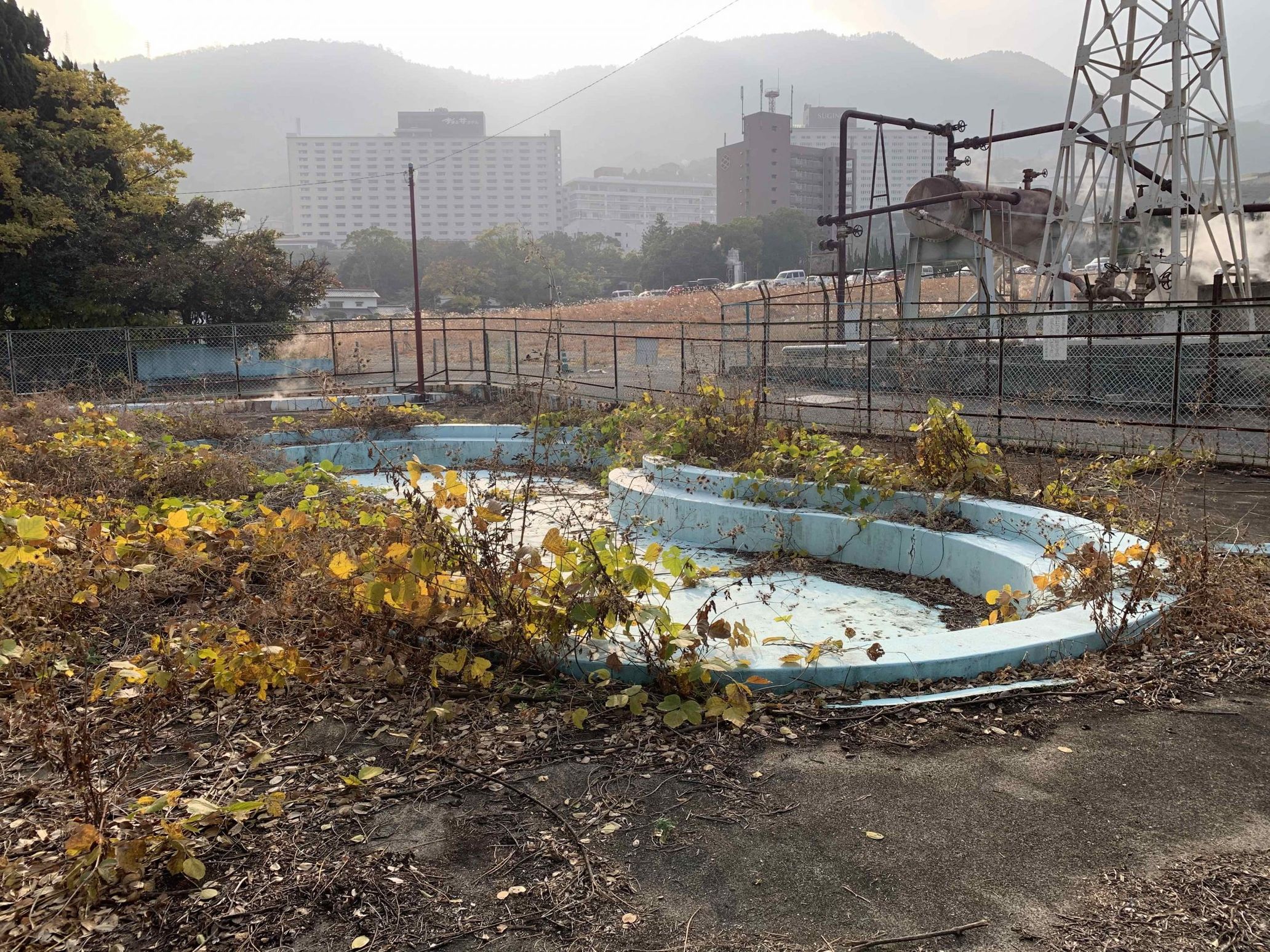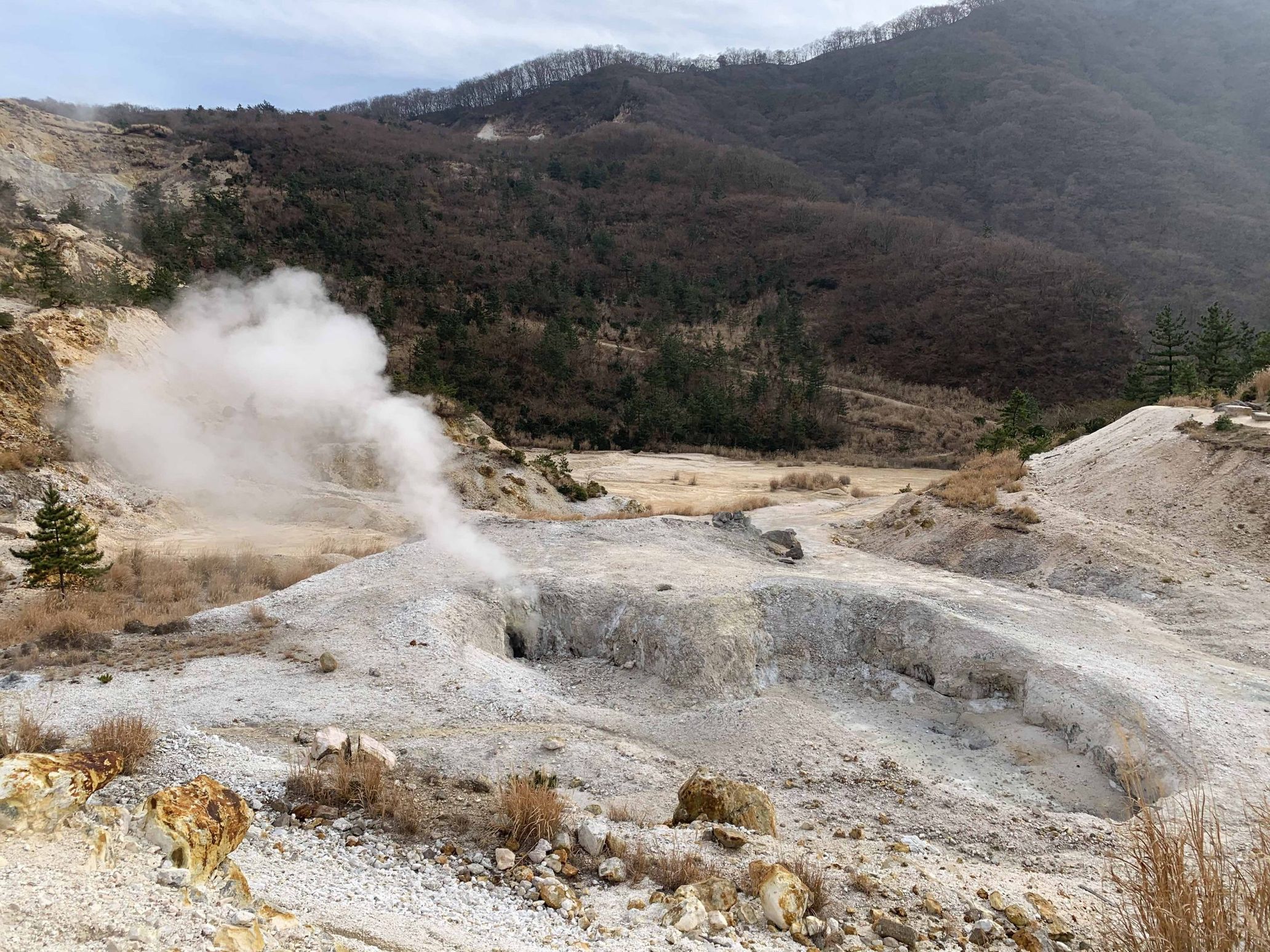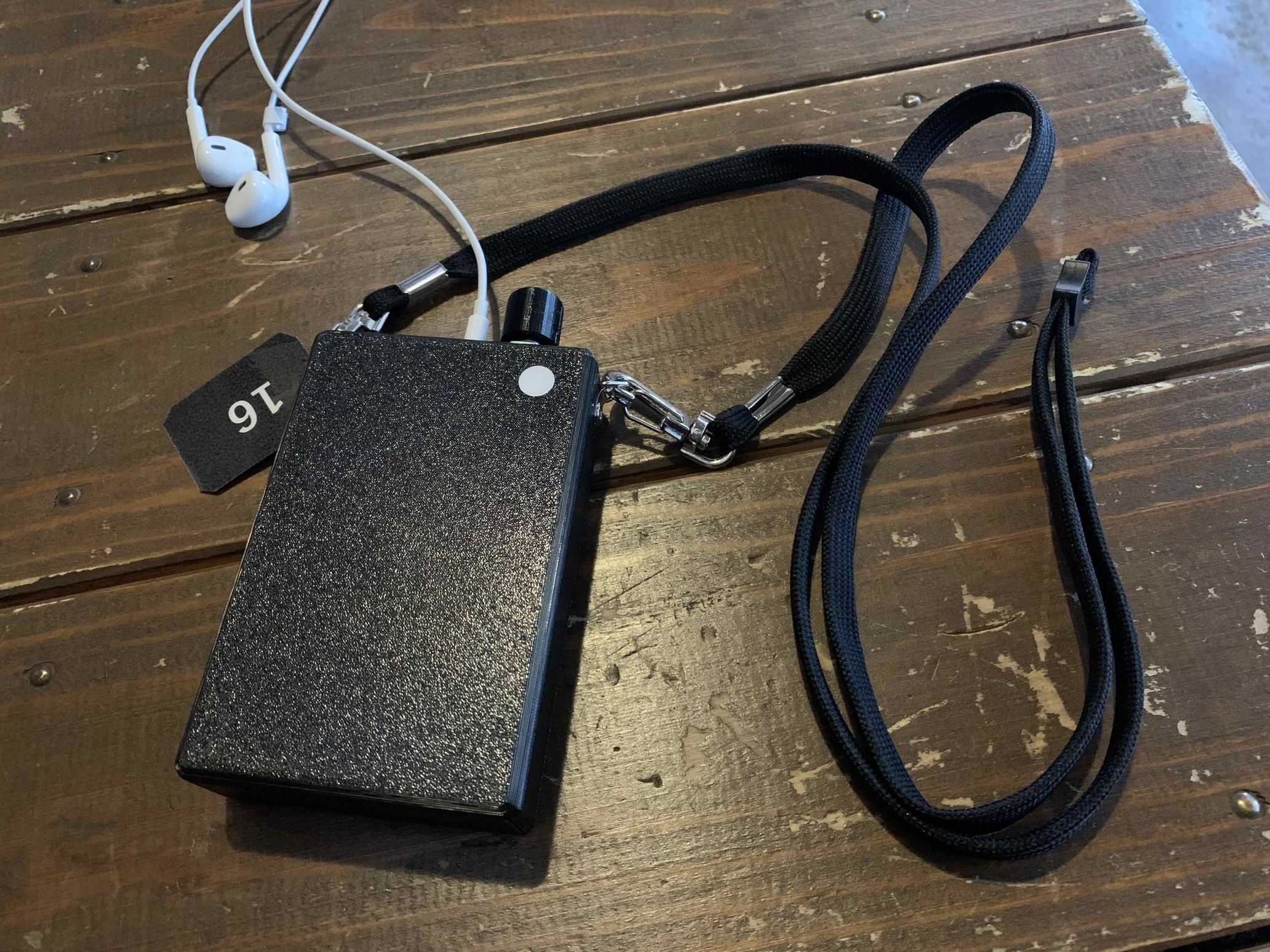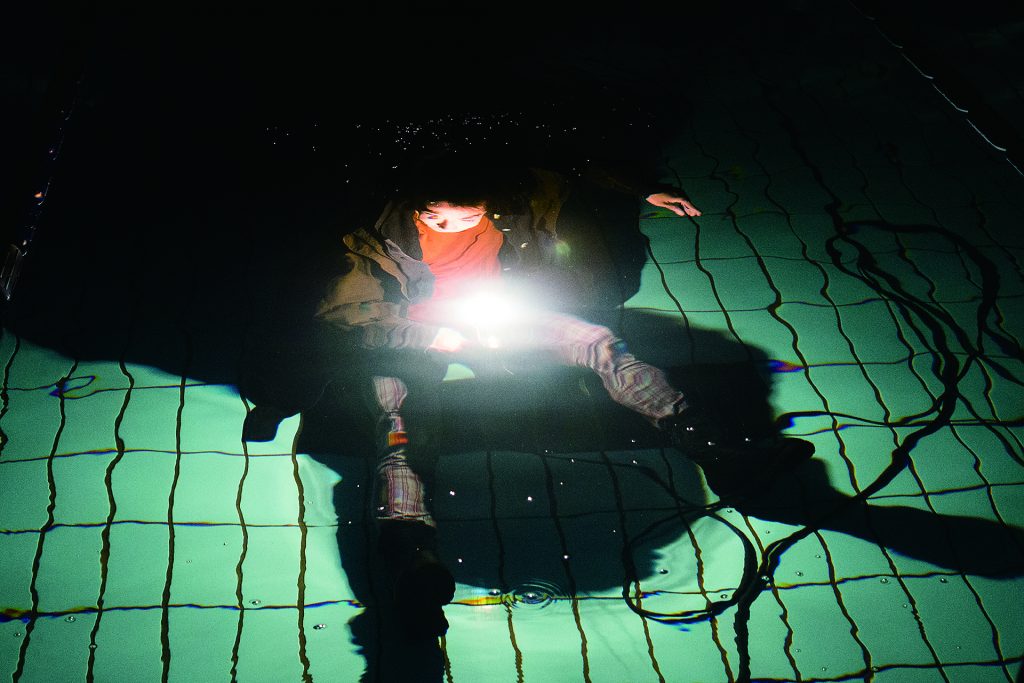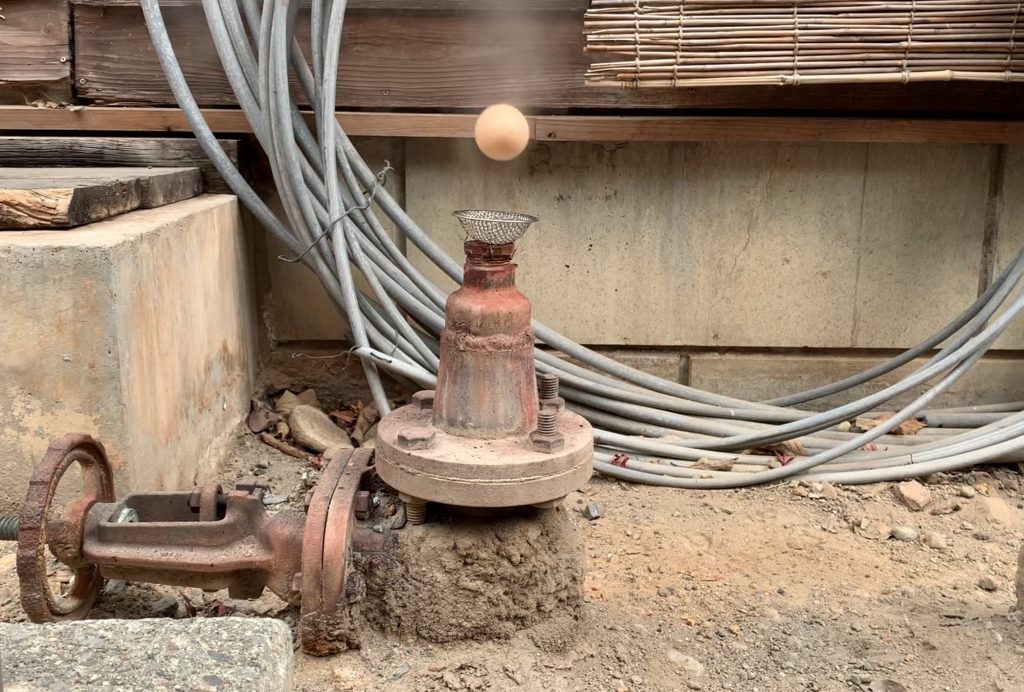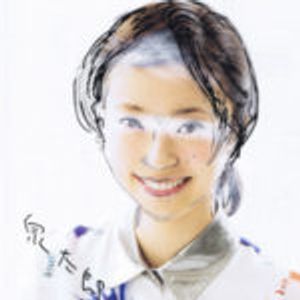An old well in a residential area. Volcanic craters at the headwaters of hot springs. As I follow the map, I hear voices here and there: “What’s beyond this hole?” and “See you on the other side of the earth next time.” Suddenly, I imagine the hole in front of me reaching the other side of the earth. I freeze in my steps. But the next moment, the corners of my mouth curl upwards from joy. From December 12th, 2020 to March 14th, 2021, an art festival in the form of a solo exhibition titled Tetsuya Umeda in Beppu “Zero-Tai” was held in Beppu, Oita prefecture.
Two magical encounters
Beppu is known for having the world’s highest number of hot springs suitable for people to enter. Steam can be seen rising everywhere. People from diverse backgrounds garner there, mesmerized by what they see. Although there are many tourists, you could sometimes run into half-naked elders on their way home from a public bathhouse. It’s a curious town indeed.
In 2009, Beppu started Mixed Bathing World, an art festival held once every three years. In 2016, they began hosting In Beppu, another art festival in which one artist/group of artists could have a solo exhibition. So far, Me, Tatzu Nishi, Anish Kapoor, and Kotaro Sekiguchi have shown their work at the festival. The fifth artist who got invited was Tetsuya Umeda.
Umeda is an artist who visualizes the invisible by interpreting and reconstructing a particular place’s structure, function, and context. He also involves people who are there and incidents that take place by chance. The audience gets thrown into a situation where they can’t discern what’s artificial and not. Their experience is akin to roaming in another dimension.
For instance, at Zero-Sai (2014), held in Sanno, Nishinari ward in Osaka, Umeda carried out a field performance where the audience used a map and encountered mysterious phenomena at different destinations. Also, at Internship (Asia Culture Center, Korea, 2016/KAAT Kanagawa Arts Theater, 2018), he dynamically “played” the theater’s mechanism, such as pulling the lighting equipment up and down and having the orchestra players tune their instruments. For Kibou no Genri (2014), a group exhibition shown at Kunisaki Art Festival organized by the Beppu Project, who also host In Beppu, he created an installation that made the audience feel the presence of a person(s) in the vault of an old town hall. In other words, Umeda is an artist who makes unusual art.
As a fan of Umeda and as someone who has ties with Beppu, I set foot, anticipating that Umeda and Beppu dramatically joining forces would be interesting. I got a PCR test just in case.
Seeing an already-existing world in a new light
Covid had a considerable effect on “Zero-Tai.” One year prior, Umeda was picturing a large-scale exhibition, including his installation works. However, because the government made a state of emergency announcement during the pandemic, he had to reconsider his approach in March 2020. To replace his original idea, he thought of using a film, map, and radio, which points to the audio the audience hears on a device with a GPS function and so forth.
To summarize, the 40-minute film depicts actor Mirai Moriyama wandering around various spots in Beppu, with Hikari Mitsushima appearing at every turn, explaining the land’s history and geography in bits and pieces. The audience could then go to the destinations shown in the film using a map and radio. The audio is of the actors’ lines, other lines they practiced in rehearsals, and the ones that got cut. This played a part in helping the audience get around Beppu. The crucial point was the scenery and experience that awaited them. One could start with either watching the film or using the map and radio. I watched the film first.
Photography Yuko AMANO
Perhaps people are first drawn to Moriyama and Mitsushima. Umeda and Moriyama met each other in July 2020 for a live-streamed theater piece, Playtime, at Theater Cocoon. Starting with Umeda’s Internship, he put Theater Cocoon in motion after it awakened from its covid-induced sleep. The piece itself was based on Kunio Kishida’s play, Rennai Kyofubyou, featuring Moriyama and Haru Kuroki. Moriyama, who saw Umeda’s performance at Superdeluxe in Roppongi (now closed) a few years before, was impressed with him: “He would pile what looked like junk on top of one another, and then would destroy that. He created an organic energy, and it was so beautiful.” Moriyama found out about Internship afterward and when He became involved in the reopening of Theater Cocoon, he suggested that he would like to work with Umeda. Umeda then became in charge of composing and directing Playtime. He asked Moriyama to join “Zero-Tai,” which was still developing at that point. Moriyama and Mitsushima are both talented actors who have co-starred numerous times.*1
The two make the film what it is (and shifts the notion of what makes a film). However, they aren’t the only ones in it. The cameramen, sound technician, the Beppu Shōsei High School brass band, who play the film’s score, and everyone involved in making the film appear in it too. In Internship, the staff—who are usually behind the scenes—and actors are treated equally as well.
Umeda describes it as “a performance of making a movie.” *2 The film was shot with a small crew on a tight schedule: they went to scout locations in October, shot it in three days in November, and released it in December. He “wrote the script in one sitting, and shot it quickly,” and apparently, it was an eccentric, unusual set.
Once I settled into my seat inside the movie theater and got immersed in the enigmatic film, suddenly, the screen showed the audience. Umeda explains: “Many things have happened during different times, but our situation today is particularly unique. I felt like I’d be telling a lie if I were to ignore our situation.” What I saw in front of me was a bizarre scene symbolizing the present.
Spots filled with mystery
After I received my map and radio, I was ready to venture out. When the exhibition started, there were 20 location pins on the map, including Beppu’s town area and tourist sites. The radio could be used in Maruido, Nakahama Suji, Beppu Spa Beach, Ichinoide Kaikan, Tsurumien, and Tsukahara Onsen Kakono Izumi. Six places in total. During the exhibition period, Beppu Ropeway, Myoban Onsen, and the Buenos Aires sea (!) were added to the list of places where the audience could use the radio.
Maruido, the first stop on the map, is in the residential area of Hamawaki, the birthplace of the hot springs of Beppu. This well was made in 1847, and people still use this water every day. As I got closer, I heard a voice from the radio: “What’s beyond this hole?” It was Mitsushima’s voice, the same one from the beginning of the film. I gently lifted the lid and peeked inside. By the way, most of the hot springs in Hamawaki have dried up, and they get the hot spring water from elsewhere. Today, Hamawaki is somewhat known for being a former red-light district. One theory is that it became a red-light district because there were no more hot springs, and the other says that it was a red-light district first. It was dark inside the well, which hasn’t dried up since the Edo period, and so I couldn’t see well. But I gained the sensibility to try to look at something I couldn’t see.
What I heard on this seemingly ordinary street, Nakahama Suji, were seagulls crying and the phrases, “With the ebb and flow of the waves, the Reichosen sways and sways” and “There are two islands; one will sink into the ocean, and the other will sink into memory.” I looked it up and found out that this area used to be a coastline. I thought about it and realized only these streets were zig-zagged. In 1893, a public bathhouse called Reichosen was built close to the Beppu harbor. Rumor has it, the temperature of the hot water altered according to the ebb and flow of the tides. Also, the Nakahama Jizo statues, which are on the way to Nakahama Suji, were made in the sixth century. Uryu island and Hisamitsu island, which used to be in the Beppu bay, sunk because of the Keicho Bungo Earthquake in 1596. It’s said that people prayed for the victims’ souls, and no more natural disasters there. When I thought about that part of history, I suddenly felt like the sand was being drawn out from between my toes.
Photography Yuko AMANO
The next place I went to was Beppu Spa Beach, after being at a former beach. It’s from the scene of the film where young-looking women in kimonos make an appearance. On the radio, I heard the line, “Many people bathe when the tide is low; saltwater cures illness well” and gunshots. According to Umeda, the young women come from the postcards from the Showa era. The gunshots are related to the special procurement boom after the war. Until the Edo era, hot springs sprung from the beaches in the area. Back then, if you dug a hole in the sand, you could have a sand bath. However, it’s filled up and is an artificial beach now. Further, from 1945 to 1957, the occupied forces built bases in Beppu, and people began to have more business opportunities. Cultures geared toward the forces developed, too. The image of the smiling women in holes also connects to bomb shelters and graves.
Ichinoide Kaikan is a catering service in conjunction with a hot springs facility where customers can enjoy the full view of the town. Once I got closer to the steamy cave behind the facility, I heard, “After playing a role, unacknowledged by anyone, it gets left behind and forgotten” and “Buenos Aires.” This place is the remains of a gold mine. Around Rakutenchi, an amusement park only 500 meters away, people dug out and sold gold from the mines starting from around 1903. But when the land began to produce hot springs, the mining came to a halt in 1916. Moreover, the whole hot springs area here is on an alluvial fan formed by the eruption of Mount Tsurumi. You could see andesites, a type of volcanic rock, here and there. The Japanese word for it, anzangan, derives from the English name, alluding to the volcanic rocks in the Andes mountains in South America. This fact makes me feel aware of how our terrains are connected to South America.
Next up was the Tsurumien. The place had overgrown weeds and an abandoned pool. Words that a tour guide might utter like “Ancient battlefield” and “Yoshihiro Muneyuki” were broadcasted, along with other phrases like “Entrance fee: adults, 40 sen. Soldier and children, 20 sen.” Yoshihiro Muneyuki was a bushō during the Sengoku period, who died in 1600 in the battle of Ishigakibaru, deemed the “Sekigahara of Kyushu.” The Tsurumi district, where Tsurumien is today, was the battlefield. In 1925, the big amusement park, Tsurumien, was established. Tsurumien Joyuu Kageki was influenced by Takarazuka Revue and played at the big theater there. They became so popular, they became known as “The Takarazuka of Kyushu.” After the war, it was seized by the occupying forces and was used as an American camp. After they returned it to Japan, the space was turned into a leisure center but closed its doors seven years later in 1976. War, pleasure, and the things human beings do all mix into one.
The sixth spot is Tsukahara Onsen Kakono Izumi in Yufuincho, a 30-minute car drive from the town area of Beppu. Once I got past the hot springs, lively with tourists, and went up a hill, I saw steam gushing out from many rocky surfaces. I could hear phrases like, “Here, two faults are bumping into each other,” “The plate you and I stand on are different,” and “Goodbye; see you on the other side of the earth next time.” Around Shimabara, Nagasaki, west of Beppu, and bordering on Kyushu, the Philippine Sea Plate in the south had sunken under the Eurasia plate in the north. That’s what caused a rift to occur, which is why active thrust faults, volcanos, and hot springs are concentrated in the area. This place is a volcano at the midway point of Garandake, the summit of Beppu’s alluvial fan. Garandake is an active volcano situated right at the point where the Kannawa fault and Asamigawa fault meet. The hot water running underground is the hot springs source for Beppu Hatto (the main eight hot springs area). If these plates continue shifting, we might see one another on the other side of the earth.
Deeper immersion provoked by not being in control
No artworks were displayed at each “venue.” You could only see the scenery, but by listening to profound audio messages, another world came to life. Also, the content and timing of the audio differed slightly from device to device. Because the circumstances of one’s surroundings were different depending on when one went there, each person’s experience was unique. Of course, the things people thought and the things people felt with their bodies differed too.
Janet Cardiff and George Bures Miller’s Walks series and recently, Akira Takayama’s group, Port B’s Heterotopia series, used audio to evoke images or history of the place. But one of the vital points of “Zero-Tai,” is the limited functionality of the audio device (called a radio for convenience), which Umeda himself was particular about. The device only has an on and off switch, volume adjuster, and lamp that blinks once it’s close to a specified location. The audience can’t play or tune it.
At first, I felt tied down and worried. This is something I felt during Umeda’s ship tour performance, Five Ships (Night Cruise Edition) (2015) as well: we usually feel like we can control most things—especially things we want to see—on the palm of our hand. However, by being unable to control things, we have no choice but to focus on the situation right in front of our eyes. Our ability to seek something and feel something becomes stronger that way.
Umeda had an informative experience with the radio. “As a child, we didn’t have a TV, so we listened to the radio. From around middle school, I would sneak out of the house at midnight and extend the antenna to pick up on radio waves from another prefecture to listen to the second part of All Night Nippon.” The tension born from activity and passivity battling one another is similar to this sensibility.
He also says he had a paramount experience related to movie theaters as a child. “There was one movie theater on the island of Amakusa in Kumamoto prefecture, where I lived, and [my parents] would take me there on the weekends. Old movie theaters don’t have lights around your feet area, so it was pitch black before the film started. It was scary and exciting.” Umeda’s film was shown at the only movie theater in the once theater-filled Beppu, Beppu Bluebird Theater, established in 1949. The journey of “Zero-Tai” started from sitting in the velvet-covered seat.
What lies beyond the “zero” of a stagnant world
Lastly, I would like to think about the title: “Zero-Tai.” You could tell that the title is ambiguous, as 0 reads as “zero” but could also indicate the letter “o.” He has used 0 for a couple of his artworks. Zero-Sai mentioned earlier, and Zero-Kai, an installation where Umeda reinterpreted the purpose of the cafeteria, lockers, and such in the basement floor of the former Omiya government office held at the Saitama International Art Festival 2020 last year, both have zero in the title. The running theme is how he revitalizes things that seem to have lost their usage by bringing a new order to them. Also, one can say that his work is “zero” because he doesn’t have easy-to-understand displays or artworks.
Also, the shape of 0 resembles a hole or a cave. The locations this time included a well, a cave, and volcanic craters. To begin with, Beppu has a lot of holes in the form of hot springs. Umeda explains, “I wanted to create a hollow.” Various exhibitions, art festivals, theater pieces, and music events got canceled because of the pandemic. But he felt doubt about stopping everything at once because of one reason. “If we’re scattered without having a core, I think it’s possible to prevent ourselves from getting rounded up.” Come to think of it, Internship also exists in a world where there’s no center, like the main actor or role.
Concerning “Tai” (滞), Umeda says, “滞 (tai) comes from 帯域 (taiiki), (which means bandwidth) because radios use radio waves. But because it was in Beppu, I wanted to use the water radical. 滞 (tai) is close to our situation right now too.” Many stagnant voices and sounds were interwoven in Beppu, and by immersing themselves in it, the audience witnessed a different world. People experienced intense immersion because it was stagnant during the pandemic.
After “Zero-Tai,” he’s planning on publishing a new book as a clue to go around Beppu. I obsessively wrote a long piece about my conjecture about the meaning behind “Zero-Tai” and what I understood from doing so was how the scenery of Beppu and Umeda’s work have a mystique that can’t be summarized.
*1 According to a talk between Tetsuya Umeda and Mirai Moriyama during a live-stream event on March 14th, 2021
*2 According to an interview with Tetsuya Umeda on December 12th, 2020 (the same applies below)
■Tetsuya Umeda in Beppu “Zero-Tai”:
The book is scheduled to be published in August

